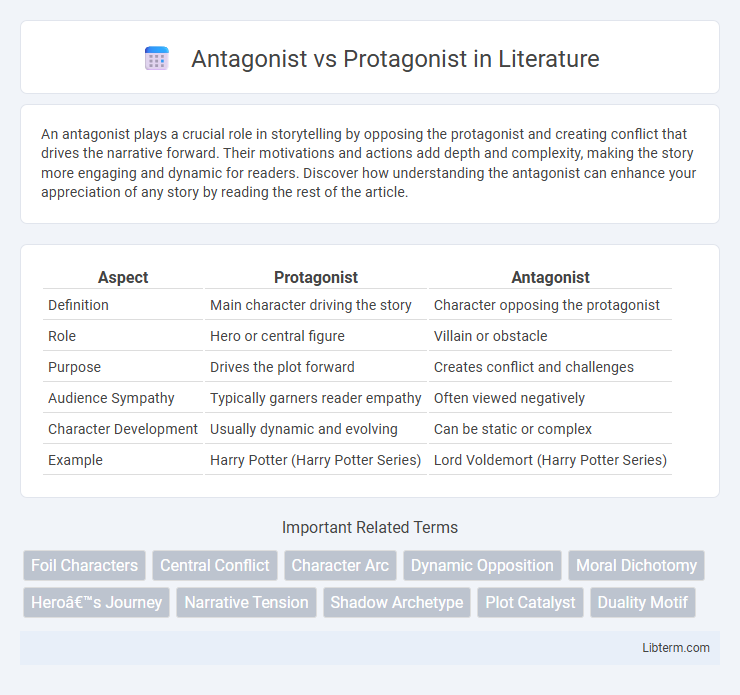An antagonist plays a crucial role in storytelling by opposing the protagonist and creating conflict that drives the narrative forward. Their motivations and actions add depth and complexity, making the story more engaging and dynamic for readers. Discover how understanding the antagonist can enhance your appreciation of any story by reading the rest of the article.
Table of Comparison
| Aspect | Protagonist | Antagonist |
|---|---|---|
| Definition | Main character driving the story | Character opposing the protagonist |
| Role | Hero or central figure | Villain or obstacle |
| Purpose | Drives the plot forward | Creates conflict and challenges |
| Audience Sympathy | Typically garners reader empathy | Often viewed negatively |
| Character Development | Usually dynamic and evolving | Can be static or complex |
| Example | Harry Potter (Harry Potter Series) | Lord Voldemort (Harry Potter Series) |
Understanding the Roles: Protagonist vs Antagonist
The protagonist serves as the main character around whom the story revolves, driving the narrative forward through their goals, struggles, and development. The antagonist opposes the protagonist by creating obstacles, conflicts, or challenges that test the protagonist's resolve and highlight moral, emotional, or ideological differences. Understanding the distinct yet interdependent roles of protagonist and antagonist enhances the depth of storytelling by clarifying motivations and intensifying dramatic tension.
Defining the Protagonist: Hero of the Story
The protagonist serves as the central character driving the narrative, embodying the hero whose goals and growth shape the story's arc. This character often faces conflicts posed by the antagonist, reflecting themes of courage, resilience, and transformation. Understanding the protagonist's motivations and development is crucial to analyzing the story's emotional and moral impact.
The Antagonist: More Than Just a Villain
The antagonist serves as a critical force opposing the protagonist's goals, often embodying complex motivations rather than mere evil intent. This character challenges the protagonist's beliefs and growth, driving the narrative tension and deepening the story's moral ambiguity. Antagonists can be heroes in their own right or flawed individuals whose actions reflect understandable desires, making them essential for multifaceted storytelling.
Core Differences Between Protagonist and Antagonist
The core difference between protagonist and antagonist lies in their narrative roles: the protagonist drives the story forward as the main character facing challenges, while the antagonist opposes the protagonist's goals, creating conflict. Protagonists typically evoke empathy as they embody the story's central objectives, whereas antagonists generate tension by obstructing progress and highlighting obstacles. This dynamic tension between protagonist and antagonist is crucial for plot development and emotional engagement in storytelling.
Motivations and Goals: Driving the Conflict
The protagonist's motivation often centers on achieving a personal goal that drives the story forward, such as seeking justice, love, or self-discovery. The antagonist's goals typically oppose the protagonist's, creating tension by prioritizing power, control, or revenge. This clash of motivations fuels the central conflict, shaping the narrative's emotional and thematic depth.
How Antagonists Shape the Protagonist’s Journey
Antagonists create conflict that tests the protagonist's values, strengths, and growth, driving the story's emotional and psychological progression. By challenging the protagonist's goals and beliefs, antagonists reveal hidden dimensions of the hero's character and motivate crucial decisions. The dynamic interplay between protagonist and antagonist ultimately shapes the protagonist's transformation and the narrative's resolution.
Sympathetic Antagonists and Flawed Protagonists
Sympathetic antagonists often possess relatable motivations or tragic backgrounds that evoke empathy despite their opposition to the protagonist, enriching the narrative complexity. Flawed protagonists exhibit human imperfections and moral ambiguities, making their journeys more compelling and authentic to readers. The dynamic interplay between these nuanced characters heightens tension and deepens emotional engagement within the story.
Popular Examples in Literature and Film
The protagonist drives the narrative forward, exemplified by Harry Potter in J.K. Rowling's series and Frodo Baggins in "The Lord of the Rings," whose journeys of growth and challenge engage audiences deeply. The antagonist, such as Voldemort from "Harry Potter" or Sauron in "The Lord of the Rings," provides the primary source of conflict, embodying opposition and obstacles that test the protagonist's resolve. Classic film examples include Darth Vader as the menacing antagonist in "Star Wars," clashing with protagonist Luke Skywalker, highlighting the timeless dynamic that fuels compelling storytelling.
Crafting Compelling Protagonists and Antagonists
Crafting compelling protagonists requires creating multidimensional characters with clear goals, internal conflicts, and relatable motivations that drive the narrative forward. Effective antagonists must embody challenges that directly oppose the protagonist's desires, offering complex motivations rather than mere villainy to enhance story depth. Balancing strengths, flaws, and evolving relationships between protagonists and antagonists increases emotional engagement and tension, making the conflict more impactful.
The Impact of Their Conflict on Storytelling
The conflict between antagonist and protagonist drives narrative tension, shaping character development and plot progression. Their opposing goals create dynamic challenges that engage readers and highlight thematic contrasts. This struggle deepens emotional investment, making stories more compelling and memorable.
Antagonist Infographic

 libterm.com
libterm.com